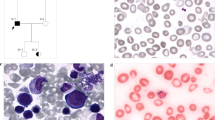Abstract
The NBS1 gene is strongly linked to several factors involved in genome integrity. Functional disruption of NBS1 could therefore induce genomic instability and carcinogenesis. Four children with acute lymphoblastic leukemia have been reported to be heterozygous for a germline and/or somatic missense mutation in NBS1, leading to the I171V substitution. We screened healthy controls and pediatric patients with hematological malignancies and aplastic anemia (AA) for the presence of I171V. Of the 62 patients, one individual with AA was confirmed to harbor a homozygous I171V mutation. Genetic analysis of NBS1 in this patient and her healthy parents indicated that she inherited the germline I171V mutation from her father and the wild-type allele from her mother, and that the second I171V hit occurred on the wild-type allele early in embryonic development. Furthermore, cytogenetic analysis of lymphoblastic cell lines from the patient indicated a remarkable increase in numerical and structural chromosomal aberrations in the absence of clastogens, suggesting that she potentially carried genomic instability. This is the first report of AA with a homozygous I171V mutation. We hypothesize that NBS1 may play an important role in the pathogenesis of AA.


Similar content being viewed by others
References
Alter BP, Young NS (1998) The bone marrow failure syndromes. In: Nathan DG, Orkin SH (eds) Hematology of infancy and childhood. Saunders, Philadelphia, pp 237–335
Bork P, Hofmann K, Bucher P, Neuwald AF, Altschul SF, Koonin EV (1997) A superfamily of conserved domains in DNA damage-responsive cell cycle checkpoint proteins. FASEB J 11:68–76
Carlomagno F, Chang-Claude J, Dunning AM, Ponder BA (1999) Determination of the frequency of the common 657Del5 Nijmegen breakage syndrome mutation in the German population: no association with risk of breast cancer. Genes Chromosomes Cancer 25:393–395
Carney JP, Maser RS, Olivares H, Davis EM, LeBeau M, Yates JR, Hays L, Morgan WF, Petrini JHJ (1998) The hMre11/hRad50 protein complex and Nijmegen breakage syndrome: linkage of double-strand break repair to the cellular DNA damage response. Cell 93:477–486
Cerosaletti KM, Morrison VA, Sabath DE, Willerford DM, Concannon P (2002) Mutations and molecular variants of the NBS1 gene in non-Hodgkin lymphoma. Genes Chromosomes Cancer 35:282–286
Hama S, Matsuura S, Tauchi H, Sawada J, Kato C, Yamasaki F, Yoshioka H, Sugiyama K, Arita K, Kurisu K, Kamada N, Heike Y, Komatsu K (2000) Absence of mutations in the NBS1 gene in B-cell malignant lymphoma patients. Anticancer Res 20:1897–1900
Harnden DG, Klinger HP (1985) An international system for human cytogenetic nomenclature. Karger, Basel
Kobayashi J, Tauchi H, Sakamoto S, Nakamura A, Morishima K, Matsuura S, Kobayashi T, Tamai K, Tanimoto K, Komatsu K (2002) NBS1 localizes to gamma-H2AX foci through interaction with the FHA/BRCT domain. Curr Biol 12:1846–1851
Matsuura S, Tauchi H, Nakamura A, Kondo N, Sakamoto S, Endo S, Smeets D, Solder B, Belohradsky BH, Der Kaloustian VM, Oshimura M, Isomura M, Nakamura Y, Komatsu K (1998) Positional cloning of the gene for Nijmegen breakage syndrome. Nat Genet 19:179–181
Nakanishi K, Taniguchi T, Ranganathan V, New HV, Moreau LA, Stotsky M, Mathew CG, Kastan MB, Weaver DT, D’Andrea AD (2002) Interaction of FANCD2 and NBS1 in the DNA damage response. Nat Cell Biol 4:913–920
Pichierri P, Rosselli F (2004) The DNA crosslink-induced S-phase checkpoint depends on ATR–CHK1 and ATR–NBS1–FANCD2 pathways. EMBO J 23:1178–1187
Pichierri P, Averbeck D, Rosselli F (2002) DNA cross-link-dependent RAD50/MRE11/NBS1 subnuclear assembly requires the Fanconi anemia C protein. Hum Mol Genet 11:2531–2546
Resnick IB, Kondratenko I, Togoev O, Vasserman N, Shagina I, Evgrafov O, Tverskaya S, Cerosaletti KM, Gatti RA, Concannon P (2002) Nijmegen breakage syndrome: clinical characteristics and mutation analysis in eight unrelated Russian families. J Pediatr 140:355–361
Seemanova E (1990) An increased risk for malignant neoplasms in heterozygotes for a syndrome of microcephaly, normal intelligence, growth retardation, remarkable facies, immunodeficiency and chromosomal instability. Mutat Res 238:321–324
Stanulla M, Stumm M, Dieckvoss BO, Seidemann K, Schemmel V, Brechlin AM, Schrappe M, Welte K, Reiter A (2000) No evidence for a major role of heterozygous deletion 657del5 within the NBS1 gene in the pathogenesis of non-Hodgkin’s lymphoma of childhood and adolescence. Br J Haematol 109:117–120
Stumm M, von Ruskowsky A, Siebert R, Harder S, Varon R, Wieacker P, Schlegelberger B (2001) No evidence for deletions of the NBS1 gene in lymphomas. Cancer Genet Cytogenet 126:60–62
The International Nijmegen Breakage Syndrome Study Group (2000) Nijmegen breakage syndrome. Arch Dis Child 82:400–406
Varon R, Vissinga C, Smeets D (1998) Nibrin, a novel DNA double-strand break repair protein, is mutated in Nijmegen breakage syndrome. Cell 93:467–476
Varon R, Reis A, Henze G, von Einsiedel HG, Sperling K, Seeger K (2001) Mutations in the Nijmegen breakage syndrome gene (NBS1) in childhood acute lymphoblastic leukemia (ALL). Cancer Res 61:3570–3572
Wu G, Lee WH, Chen PL (2000) NBS1 and TRF colocalize at promyelocytic leukemia bodies during later S/G2 phases in immortalized telomerase negative cells: implications of NBS1 in alternative lengthening of telomeres. J Biol Chem 275:30618–30622
Young NS, Maciejewski J (1997) The pathophysiology of acquired aplastic anemia. N Engl J Med 336:1365–1372
Zhu XD, Kuster B, Mann M, de Petrini JHJ, Lange T (2000) Cell-cycle regulated association of RAD50/MRE11/NBS1 with TRF2 and human telomeres. Nat Genet 25:347–352
Acknowledgements
We thank Drs. M. Sasaki, K. Sugita, and T. Suzuki for providing patient samples. We also thank M. Mori and C. Hatanaka for technical assistance. This work was supported by the Program for Promotion of Fundamental Studies in Health Sciences of the Organization for Drug ADR Relief, R and D Promotion, and Product Review of Japan.
Author information
Authors and Affiliations
Corresponding author
Additional information
H. Shimada and K. Shimizu contributed equally to this work
Rights and permissions
About this article
Cite this article
Shimada, H., Shimizu, K., Mimaki, S. et al. First case of aplastic anemia in a Japanese child with a homozygous missense mutation in the NBS1 gene (I171V) associated with genomic instability. Hum Genet 115, 372–376 (2004). https://doi.org/10.1007/s00439-004-1155-1
Received:
Accepted:
Published:
Issue Date:
DOI: https://doi.org/10.1007/s00439-004-1155-1




